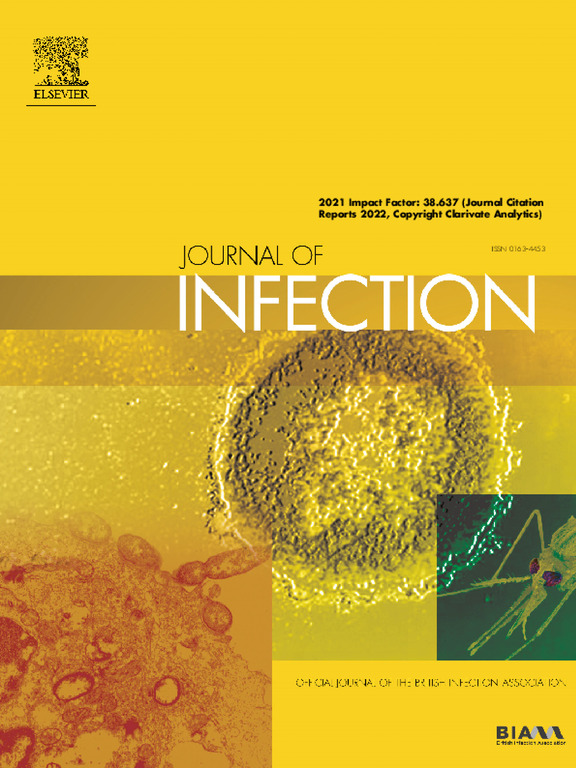呼吸道合胞病毒感染儿童和成人鼻类器官的单细胞测序分析揭示了年龄差异、增殖多样性并确定了新的细胞趋向性。
IF 11.9
1区 医学
Q1 INFECTIOUS DISEASES
引用次数: 0
摘要
呼吸道合胞病毒(RSV)是全球婴儿死亡的主要原因。年龄是影响幼儿感染严重程度的一个重要因素。RSV主要感染气道上皮纤毛细胞,诱导粘液分泌过多,损害纤毛黏液清除。为了开发有效的治疗干预措施,需要在细胞水平上更好地了解RSV感染。为了研究年龄差异并全面了解与RSV感染相关的基因特征,我们对感染RSV的成人和儿童人鼻类器官(HNOs)进行了单细胞转录组学分析。我们的分析揭示了成人和儿童HNOs在细胞分化和增殖途径相关的转录组特征上的显著差异。此外,我们发现对RSV感染有明显的先天免疫反应,儿童HNO反应较低且失调。通过对纤毛细胞群的亚聚类分析,我们确定了原代纤毛细胞是一种新的、突出的易感染RSV的纤毛细胞类型。有趣且出乎意料的是,我们发现在儿童中,与成人相比,HNO RSV感染其他新型气道细胞,包括基底细胞和离子细胞/簇状细胞,这可以通过RSV基因计数增加和干扰素相关途径的诱导来证明。总之,我们的研究提供了第一个HNO细胞图谱,揭示了成人和儿童HNO在呼吸道上皮中RSV感染的异质性,并鉴定了对RSV感染易感的新细胞类型,这为RSV发病机制、治疗方法和疫苗的研究提供了关键资源。本文章由计算机程序翻译,如有差异,请以英文原文为准。
Single cell sequencing analysis of respiratory syncytial virus–infected pediatric and adult human nose organoids reveals age differences, proliferative diversity and identifies novel cellular tropism
Respiratory syncytial virus (RSV) is a leading cause of infant death across the globe. Age is a significant factor that contributes to the severity of infection in young children. RSV primarily infects the ciliated cells of the airway epithelium, induces mucus hypersecretion, and impaired mucociliary clearance. Better understanding of RSV infection at the cellular level is needed for the development of effective therapeutic interventions. To investigate the age difference and comprehensively understand gene signatures associated with RSV infection, we performed single-cell transcriptomic analysis of adult and pediatric human nose organoids (HNOs) infected with RSV. Our analysis revealed a significant difference in transcriptomic signature associated with cellular differentiation and proliferative pathways between the adult and pediatric HNOs. Moreover, we found a distinct innate immune response to RSV infection, with pediatric HNO revealing a lower and dysregulated response. Through sub-clustering analysis of the ciliated cell population, we identified the primary ciliary cell as a novel and prominent susceptible ciliary cell type to RSV infection. Intriguingly and unexpectedly, we found that in the pediatric more than in the adult, HNO RSV infects other novel airway cells, including basal cells, and ionocytes/tuft cells, as demonstrated by increased RSV-gene counts and induction of interferon-related pathways. Together, our study provides the first HNO cell atlas dissecting the heterogeneity of RSV infection in airway epithelium between adult versus pediatric HNOs and identifies novel cell types that are susceptible to RSV infection, which altogether provides a key resource for research on RSV pathogenesis, therapeutics and vaccines.
求助全文
通过发布文献求助,成功后即可免费获取论文全文。
去求助
来源期刊

Journal of Infection
医学-传染病学
CiteScore
45.90
自引率
3.20%
发文量
475
审稿时长
16 days
期刊介绍:
The Journal of Infection publishes original papers on all aspects of infection - clinical, microbiological and epidemiological. The Journal seeks to bring together knowledge from all specialties involved in infection research and clinical practice, and present the best work in the ever-changing field of infection.
Each issue brings you Editorials that describe current or controversial topics of interest, high quality Reviews to keep you in touch with the latest developments in specific fields of interest, an Epidemiology section reporting studies in the hospital and the general community, and a lively correspondence section.
 求助内容:
求助内容: 应助结果提醒方式:
应助结果提醒方式:


